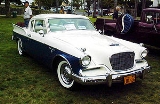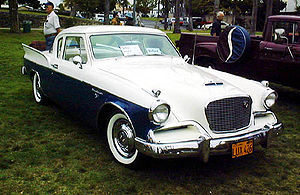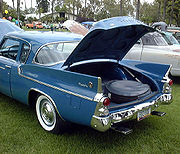
Studebaker Silver Hawk
Encyclopedia

Automobile
An automobile, autocar, motor car or car is a wheeled motor vehicle used for transporting passengers, which also carries its own engine or motor...
produced between 1957 and 1959 by the Studebaker
Studebaker
Studebaker Corporation was a United States wagon and automobile manufacturer based in South Bend, Indiana. Founded in 1852 and incorporated in 1868 under the name of the Studebaker Brothers Manufacturing Company, the company was originally a producer of wagons for farmers, miners, and the...
Corporation of South Bend, Indiana
South Bend, Indiana
The city of South Bend is the county seat of St. Joseph County, Indiana, United States, on the St. Joseph River near its southernmost bend, from which it derives its name. As of the 2010 Census, the city had a total of 101,168 residents; its Metropolitan Statistical Area had a population of 316,663...
. The Hawk was also produced in 1956. There were four versions, pillared Flight Hawk and Power Hawk, and hardtop Sky Hawk and Golden Hawk. The Silver Hawk model was not produced in 1956, the first year of the Hawks. The same basic car was produced for two more years (1960 and 1961) as simply the Studebaker Hawk, since from 1959 onward no other Hawk models were being sold.
1957-58
The Silver Hawk was the replacement for the two lower models in the four-model Hawk range in 1956, the Flight HawkStudebaker Flight Hawk
The Studebaker Flight Hawk was the lowest-priced model in the four-model Hawk family sports car line introduced by Studebaker in 1956.-Styling:...
which carried the Champion
Studebaker Champion
The Studebaker Champion is an automobile which was produced by the Studebaker Corporation of South Bend, Indiana from the beginning of the 1939 model year until 1958....
185 cu. in., six-cylinder 101 HP powerplant and the Power Hawk
Studebaker Power Hawk
The Studebaker Power Hawk was a two-door pillared coupe manufactured by the Studebaker-Packard Corporation for the 1956 model year only. The Power Hawk was technically part of the Studebaker Commander series, and featured the Commander's 259 cubic inch V-8, which generated with two-barrel...
with the Commander
Studebaker Commander
The Studebaker Commander is the model-name of a long succession of automobiles produced by the Studebaker Corporation of South Bend, Indiana and Studebaker of Canada Ltd of Walkerville and, later, Hamilton, Ontario . Studebaker began using the Commander name in 1927 and continued to use it until...
's 259 in³ (4.2L) V8. Both of these models were two-door pillared coupes in the US market (based on the 1953 "Starlight" coupe body), and therefore, so was the Silver Hawk, which came in two differently-engined models with either the aforementioned Champion six or the 289 cu. in. (4.7L) President V8 engine (delivering 210 HP from the two-barrel, 225 HP from the four-barrel with dual exhaust). The Commander V8 was not offered in U.S. models; it was, however, the largest engine available in most overseas markets.
In appearance, the Silver Hawk was somewhat plainer in appearance than the Golden Hawk
Studebaker Golden Hawk
The Studebaker Golden Hawk is a two-door pillarless hardtop coupe type car produced by the Studebaker Corporation of South Bend, Indiana between 1956 and 1958.-Styling:...
, the senior of the two Hawk models in 1957-58. There was a little bit less chrome, no supercharger or bulge in the hood, and a simpler two-tone paint scheme was adopted - simply one color below the chrome belt line and another above, but unlike the Golden Hawk, the lower color included the fin. Some dealers painted the fin only, and sometimes the deck lid recess and or the left and right "side grills" were painted in a contrasting Studebaker color. These usually matched the interior, some were Blue, Gold, Red or Black and were actually better looking according to many owners than the factory two-tone paint scheme.
In the midst of a financial crisis at Studebaker after a disastrous recession-year performance in 1958, the Golden Hawk was dropped; the Silver Hawk, which had sold somewhat better, was retained in the lineup.
1959
For 1959, the Silver Hawk became the only Hawk model in production, largely because Studebaker dealers wanted a glamorous flagship model as a dealership draw. Those customers would more than likely walk out with Studebaker's last-ditch hope, the new LarkStudebaker Lark
The Studebaker Lark is a "compact car" which was produced by Studebaker from 1959 to 1966.From its introduction in early 1959 until 1962, the Lark was a product of the Studebaker-Packard Corporation. In mid-1962, the company dropped "Packard" from its name and reverted to its pre-1954 name, the...
compact. In fact, the Silver Hawk was the only non-Lark model kept.
Changes for 1959 included new tailfins, with the "Silver Hawk" script moved to the fins instead of on the trunk lid (where new individual block letters spelling out STUDEBAKER were placed), with a new Hawk badge in between the two words. The parking lights moved to the side grilles from the front fenders, chrome moldings around the windows (from the '53-'54 models) similar to the Golden Hawk were added, and the interior was somewhere in between the two former models' levels of luxury. Two-tone paint was discontinued for all US orders, though it was still available for export.

The 1959 model year was Studebaker's first profitable year in six years, thanks mostly to the Lark, and the rising tide of sales lifted the Silver Hawk, which sold 7,788 examples.
For 1960, Studebaker dropped the Silver part of the name, leaving "just plain" Hawk. Largely unchanged externally from the '59, internally, the major change was the return of the 289 cubic inch (4.7 L) V8 last used in 1958. This was the only engine available for U.S. orders in both 1960 and 1961, the last year of the finned Hawk. Some 6-cylinder and 259 in³ (4.2 L) V8 models were built for export markets.
The 1961 models saw the limited return of a second paint color, beige, in a stripe along the base of the fin between the two lower moldings. Interiors gained the option of wide, comfortable bucket seats; customers could opt to team their 289 V8 with a new four-speed Borg-Warner manual transmission, the same model used in the Chevrolet Corvette
Corvette
A corvette is a small, maneuverable, lightly armed warship, originally smaller than a frigate and larger than a coastal patrol craft or fast attack craft , although many recent designs resemble frigates in size and role...
.
The Hawk was replaced for 1962 by the stunningly-restyled (by Brooks Stevens
Brooks Stevens
Clifford Brooks Stevens was an American industrial designer of home furnishings, appliances, automobiles and motorcycles — as well as a graphic designer and stylist....
) Studebaker Gran Turismo Hawk
Studebaker Gran Turismo Hawk
The Studebaker Gran Turismo Hawk , a sporty coupe sold between 1962 and 1964, was the final development of the Studebaker Hawk series that began with the Golden Hawk of 1956.-Redesigning the Hawk:...
.
Almost the end of the line?
When the 1960 model year began, U.S. automakers were in the throes of a steel strike, and the shortage of steel hit Studebaker, which was a much smaller company than AMC or the Big Three, particularly hard.Studebaker had a proven sales winner in the 1959 Lark, which was continued into 1960 with little change. With steel in short supply, the company chose to focus on building as many Larks as possible to ensure an adequate supply for the company's dealers. This meant that Silver Hawk production for 1960, which had been scheduled to begin in November or December 1959, was delayed.
Unfortunately for Studebaker—but fortunately for Hawk buyers—sales of the Lark began to fall off in the closing months of 1959. By the beginning of February 1960, Hawks finally began to roll from the South Bend assembly line.
It isn't known what might have happened had Lark sales continued at their 1959 levels, but speculation has been advanced that the company might not have produced any Hawks. The lengthy delay between new-model announcement time and the start of Hawk production in 1960 shows just how close Studebaker came to not producing a model that they had at least halfheartedly promoted in print advertising and showroom brochures.
Fortunately, though, the Hawk lived on, and later that year a stock production model won its class in the 1960 Mobil Economy Run
Mobil Economy Run
Mobil Economy Run was an event that took place every year from 1936 to 1968. It was designed to provide real fuel efficiency numbers during a coast to coast test on real roads and with regular traffic and weather conditions...
, delivering 22.9 miles per gallon.

